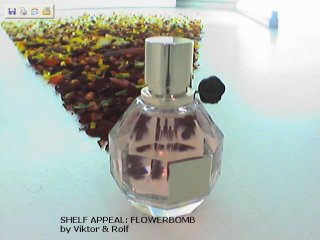SHELF APPEAL: FLOWERBOMB
by Viktor & Rolf
Once the aesthetic aspirations of a cultural epoch are achieved, one of two
things happens. Either the movement self-destructs, its ideology torn down
and replaced with a more salient one or else visual statements are pushed
beyond the initial goal, towards a more extreme form of beauty than
originally envisaged.
In art, Michelangelo is the most famous example of this. Unsatisfied by the
resolution of single-point perspective and realisation of the classical nude
achieved in his painting, Michelangelo's later work progressed beyond
reality, into convoluted compositions populated by figures with improbable
physiques. For him, nature was not enough; only the visual complexity and
emotional intensity of Mannerism could reach the extreme beauty he imagined.
The comparison may itself be extreme, but if there was ever a fashion
equivalent of Michelangelo's Mannerism, it is in the designs of Viktor &
Rolf. Having mastered the technical requirements of haute couture in their
early shows, the Dutch designers' subsequent collections of ready-to-wear
have radically extended the possibilities of what might be accepted as
clothing. Multiple collars, stacked on top of each other like an armadillo,
long, attenuated sleeves, oversize poke-your-eye-out cuffs with enormous
buttons, asymmetrical shirt plackets, trouser legs emerging from evening
gowns; this is the lexicon of exaggerated forms Viktor & Rolf drawn upon to
create the most audacious garments in contemporary fashion.
Yet there is also a latent commercialism behind the Mannerist imperative
that marks the designers out from other fashion extremists, maintaining
Viktor & Rolf's relevance to international fashion design and their market
both. That they understand the politics of global fashion branding Viktor &
Rolf made clear seasons ago, when in 1996 they launched a spurious
fragrance, for which only the corporate identity and packaging existed.
October's Spring/Summer '04 catwalk presentation saw them do it for real as
their ribbon-strewn procession built into an acoustic crescendo, echoing the
word 'Flowerbomb', the title of their new perfume.
Fashioned like a multi-faceted glass grenade, with the landmark V&R black
seal as the pin, the Flowerbomb bottle is a perfect metaphor for the Viktor
& Rolf paradox: latent violence laced with seductive elegance. Even the
packaging has been carefully considered to represent the dual concerns. From
a distance, the box looks like a Futurist car crash of force lines
culminating in a central black splat. In the hand, though, it is a pretty
arrangement of black and silver petersham ribbon on iridescent pink card,
secured by the faux wax seal.
As fashion design struggles for ideas beyond recycling old ones and
image-making yearns for new life outside stultifying re-touching, Flowerbomb
poses the opposing twin options of aesthetic accomplishment: do we tear it
all down or push it a little further?
Text by Penny Martin
by Viktor & Rolf
Once the aesthetic aspirations of a cultural epoch are achieved, one of two
things happens. Either the movement self-destructs, its ideology torn down
and replaced with a more salient one or else visual statements are pushed
beyond the initial goal, towards a more extreme form of beauty than
originally envisaged.
In art, Michelangelo is the most famous example of this. Unsatisfied by the
resolution of single-point perspective and realisation of the classical nude
achieved in his painting, Michelangelo's later work progressed beyond
reality, into convoluted compositions populated by figures with improbable
physiques. For him, nature was not enough; only the visual complexity and
emotional intensity of Mannerism could reach the extreme beauty he imagined.
The comparison may itself be extreme, but if there was ever a fashion
equivalent of Michelangelo's Mannerism, it is in the designs of Viktor &
Rolf. Having mastered the technical requirements of haute couture in their
early shows, the Dutch designers' subsequent collections of ready-to-wear
have radically extended the possibilities of what might be accepted as
clothing. Multiple collars, stacked on top of each other like an armadillo,
long, attenuated sleeves, oversize poke-your-eye-out cuffs with enormous
buttons, asymmetrical shirt plackets, trouser legs emerging from evening
gowns; this is the lexicon of exaggerated forms Viktor & Rolf drawn upon to
create the most audacious garments in contemporary fashion.
Yet there is also a latent commercialism behind the Mannerist imperative
that marks the designers out from other fashion extremists, maintaining
Viktor & Rolf's relevance to international fashion design and their market
both. That they understand the politics of global fashion branding Viktor &
Rolf made clear seasons ago, when in 1996 they launched a spurious
fragrance, for which only the corporate identity and packaging existed.
October's Spring/Summer '04 catwalk presentation saw them do it for real as
their ribbon-strewn procession built into an acoustic crescendo, echoing the
word 'Flowerbomb', the title of their new perfume.
Fashioned like a multi-faceted glass grenade, with the landmark V&R black
seal as the pin, the Flowerbomb bottle is a perfect metaphor for the Viktor
& Rolf paradox: latent violence laced with seductive elegance. Even the
packaging has been carefully considered to represent the dual concerns. From
a distance, the box looks like a Futurist car crash of force lines
culminating in a central black splat. In the hand, though, it is a pretty
arrangement of black and silver petersham ribbon on iridescent pink card,
secured by the faux wax seal.
As fashion design struggles for ideas beyond recycling old ones and
image-making yearns for new life outside stultifying re-touching, Flowerbomb
poses the opposing twin options of aesthetic accomplishment: do we tear it
all down or push it a little further?
Text by Penny Martin





 ).
).

